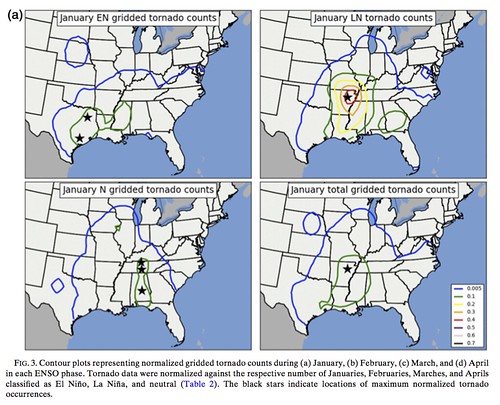In recent years, interest in seasonal forecasts of the frequency and severity of severe weather has grown, especially since 2011. The year was an extreme for tornado outbreaks, resulting in over 500 deaths, thousands of injuries, and more than $10 billion in damage. The 2011 season ranked the second-highest number of tornadoes since the 1950s, falling just short of the 1974 season, which included the 1974 Super Outbreak. The 2011 tornado outbreaks between April 25th and April 28th alone produced over 300 tornadoes confirmed by the National Weather Service.
The U.S. presidential administration stated the need for seasonal forecasts of tornadic activity. The goal of this would be to provide guidance on the level of severe weather occurrences expected for the year. One way forecasters may predict the severity and risk during tornado season is to connect variations in the frequencies of tornadic storms to atmospheric teleconnections over the Pacific, such as the phase and magnitude of El Niño Southern Oscillation (ENSO). The Impact of El Niño-Southern Oscillation (ENSO) on Winter and Early Spring U.S. Tornado Outbreaks aims to expand previous research by exploring winter and early spring tornado forecast potential by diagnosing the influence of El Niño/La Niña on January-April 1950-2010 U.S. tornado outbreaks.
Summary
This study assesses how synoptic-scale atmospheric features commonly associated with tornado outbreaks shift with ENSO. This approach allows linkages to be established between individual tornado outbreaks and ENSO. This kind of climatological assessment of atmospheric factors gives insight regarding catalysts for upward vertical motion and convective development not found in other ways of indexing tornadoes. This research further relates various phases of ENSO to variations in tornado counts, tornado days, and the destruction potential index.
The study includes tornado outbreaks dating back to 1950 to provide a more robust basis than studies conducted on ENSO and tornado climatology in the past. A grid based on latitude and longitude was used to assess tornado counts for 24-h periods. The gridding process provides an enhancement to other spatial analysis of tornado because it incorporates entire tornado tracks instead of touchdown points. Individual monthly sea surface temperatures were used to assess the strength of El Niño conditions.

To diagnose the impact of ENSO on tornado outbreaks, gridded tornado counts were normalized by monthly frequency of occurrence of each ENSO phase from 1950-2010. Patterns suggest tornado activity during El Niño months occurs farther south than in other ENSO phases. The majority of tornado outbreaks during El Niño take place in eastern Texas and Mississippi from January to March. In contrast, tornado outbreaks typically occur north of this region during La Niña years, with maxima in central Arkansas. During La Niña years, there is a dramatic increase of tornadoes in the Great Plains and Ohio in April compared to El Niño years.
Furthermore, stronger, longer-lived tornadoes in outbreaks are observed during La Niña conditions, especially during January and February. The trend is much less pronounced in March and April, but still exists. The strongest tornado activity during the El Niño phase is consistently focused around the southern United States in all months of the study.
This study helps meteorologists because it provides a foundation for prediction of tornado seasons in the United States. Meteorologists can use El Niño data to predict the geographic concentration and possible strength of tornado outbreaks on a monthly basis using sea surface temperature data from the Pacific. This study also uses tornado strength as a metric of study instead of just tornado count, which allows for prediction of possible tornado damage during the season.
Further Research
This study could expand on three things. First, it could be researched how other atmospheric teleconnections impact tornado seasons in the United States and possibly interfere with the effects of ENSO. Second, the study could discuss if El Niño’s impact on hurricane season has any correlation with its impact on tornadoes. Finally, the study could draw annual conclusions from the monthly data to draw conclusions about entire El Niño/ La Niña outbreak years, and focus on tornadoes later in the year such as the small peaks in November.
Work Cited
Robinson Cook, Ashton & Leslie, Lance & Parsons, David & T. Schaefer, Joseph. (2017). The Impact of the El Niño Southern Oscillation (ENSO) on Winter and Early Spring U.S. Tornado Outbreaks. Journal of Applied Meteorology and Climatology. 56. 10.1175/JAMC-D-16-0249.1.

